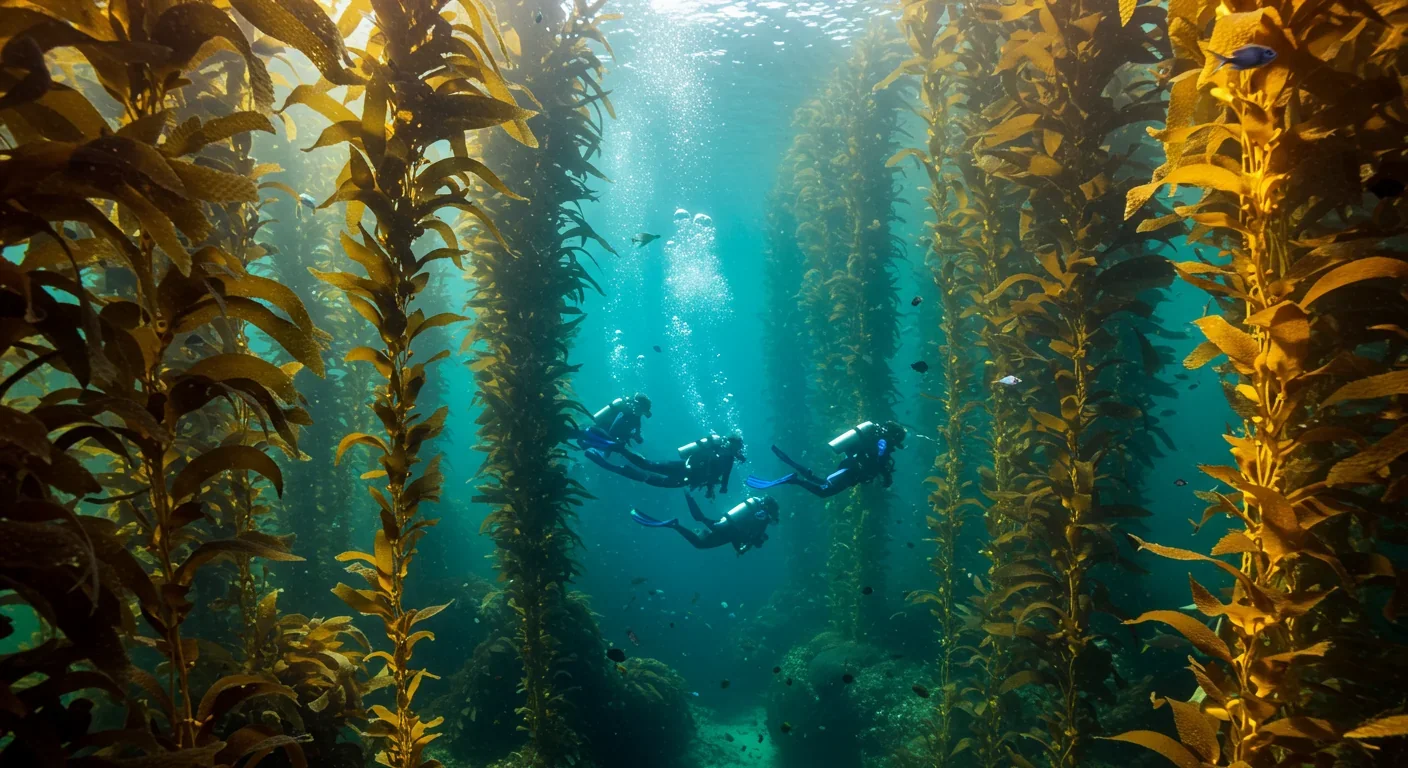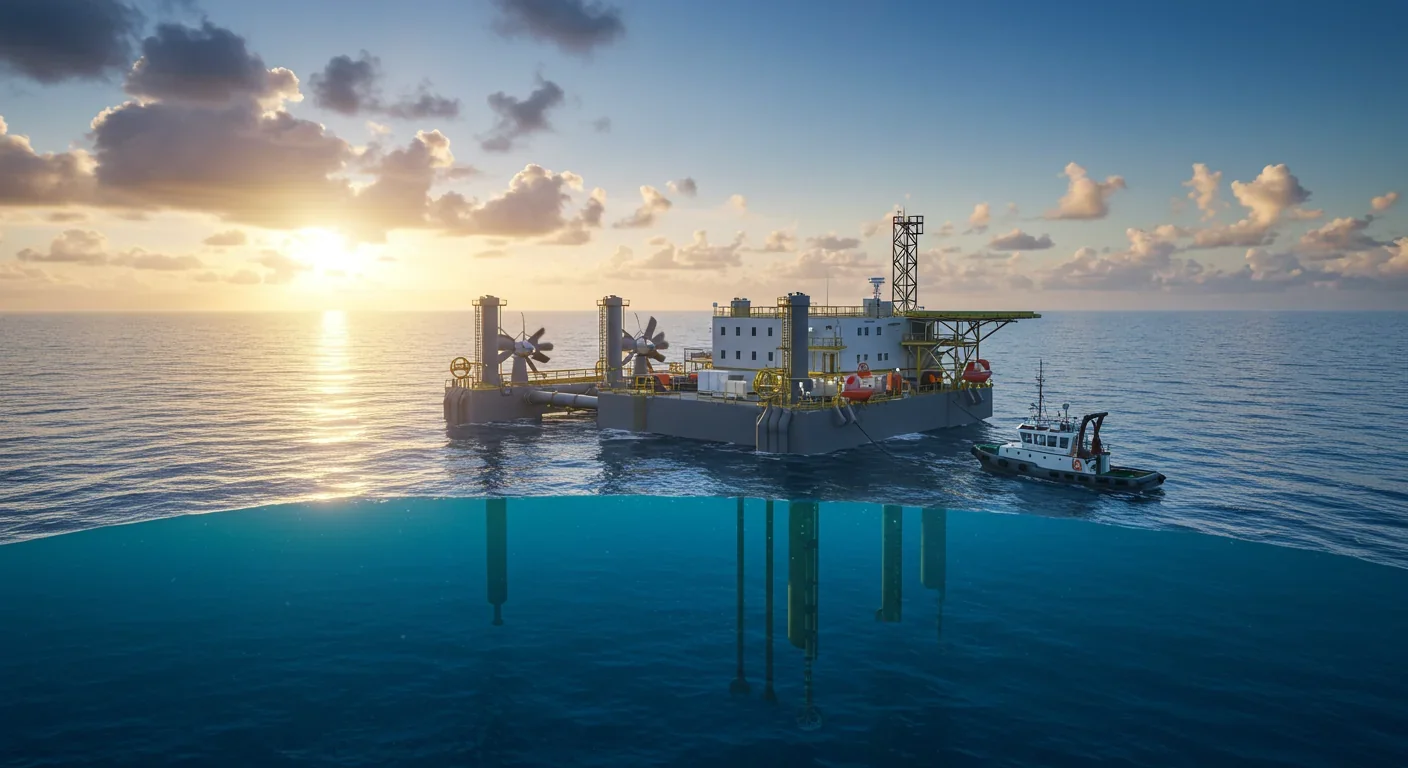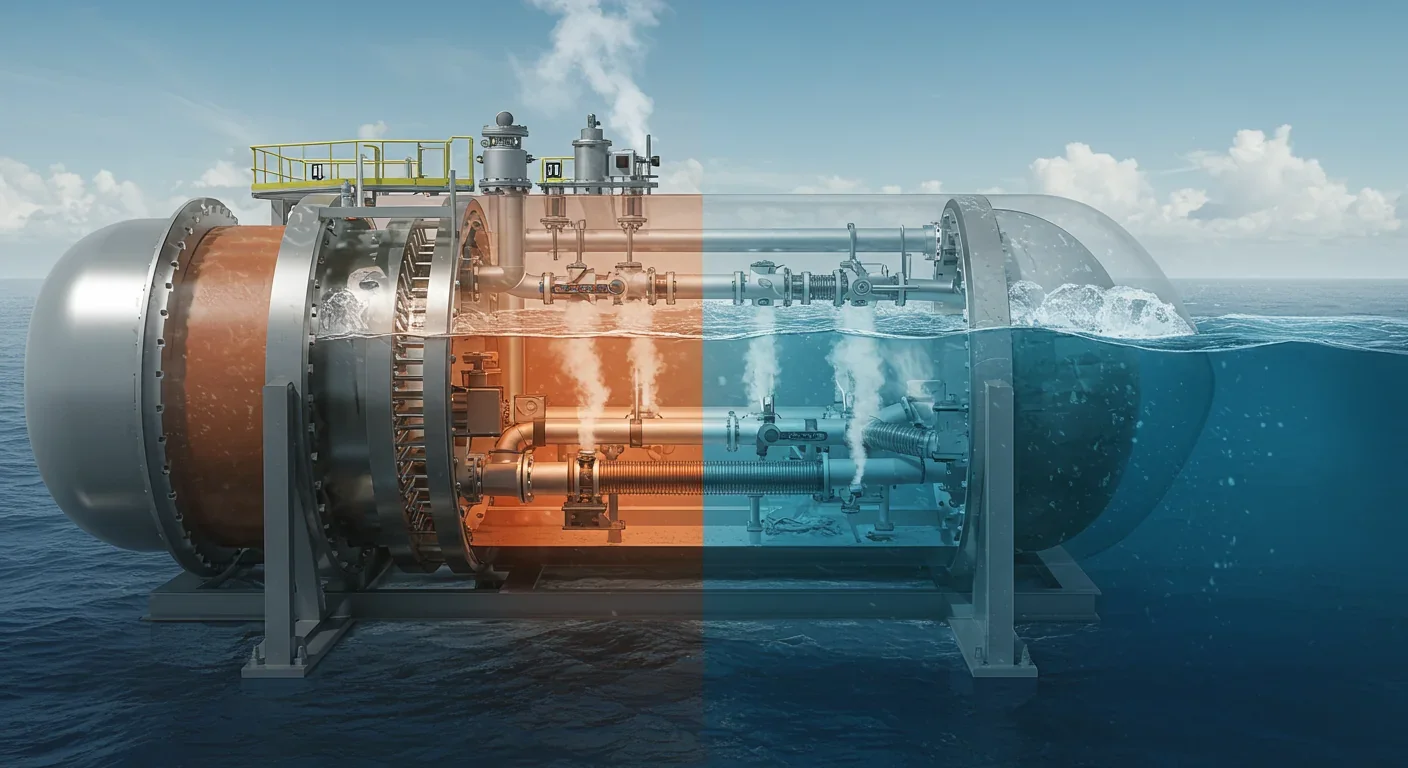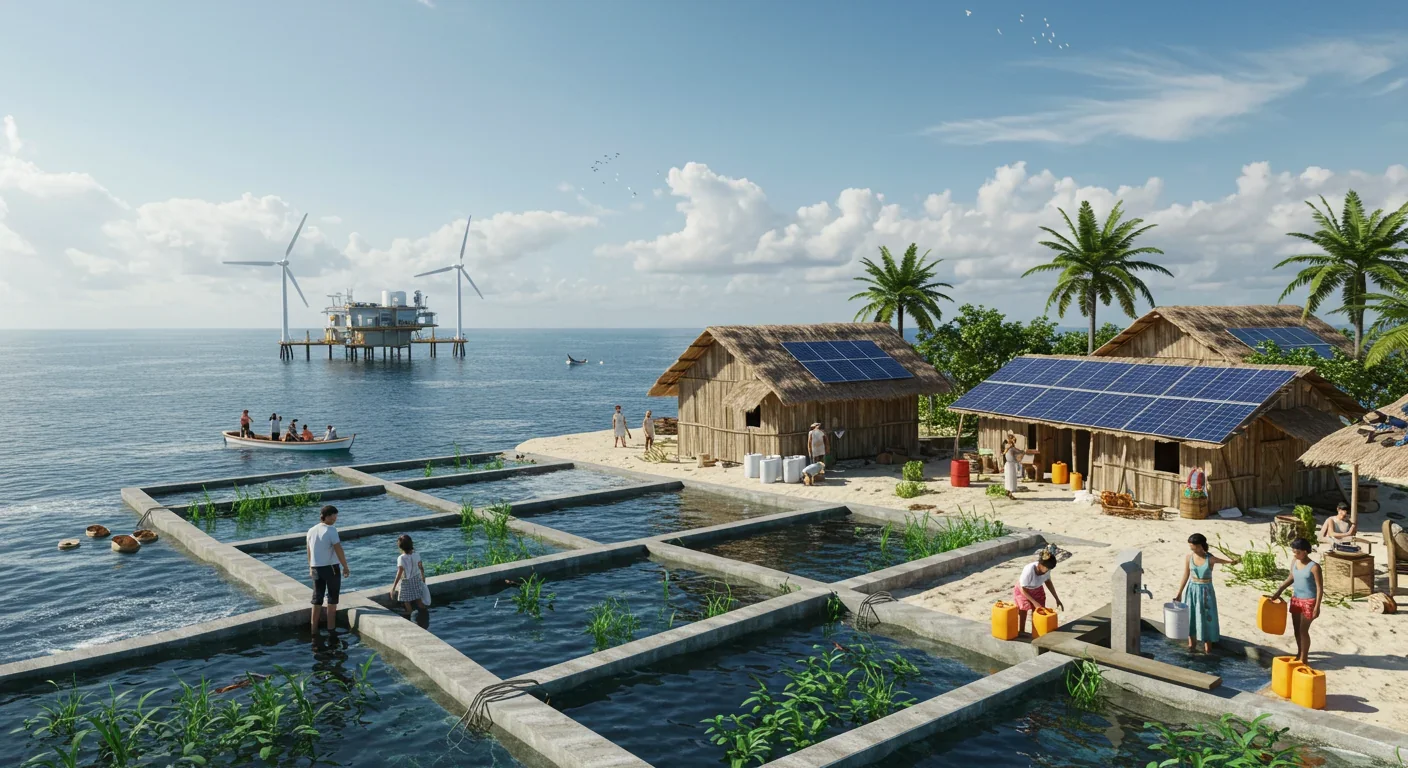Kelp Forests and Climate Change: Marine Permaculture Guide

TL;DR: Ocean Thermal Energy Conversion (OTEC) harnesses the temperature difference between warm surface water and cold deep ocean water to generate baseload renewable electricity 24/7—unlike intermittent solar and wind. With proven pilot plants in Japan and South Korea, modular designs, and projected costs falling to 6–7 cents per kWh by 2050, OTEC could power 3 billion people in tropical regions while co-producing freshwater and supporting aquaculture. The technology faces challenges in capital cost and environmental monitoring, but international collaboration and innovative heat exchangers are bringing this ocean-powered revolution within reach.

By 2050, a technology hiding in plain sight could generate electricity at 6–7 cents per kilowatt-hour while simultaneously producing fresh drinking water and supporting coastal fisheries. Ocean Thermal Energy Conversion (OTEC) harnesses the temperature difference between warm surface water and the frigid depths to run heat engines 24 hours a day, 365 days a year. While solar panels sleep at night and wind turbines idle in calm weather, OTEC platforms floating in tropical seas could deliver baseload renewable power to over 3 billion people—yet most policymakers have never heard of it. The ocean absorbs heat equivalent to 250 billion barrels of oil every single day. What if we could tap that reservoir without burning a single fossil fuel?
In March 2013, Okinawa Prefecture completed the world's only fully operational Ocean Thermal Energy Conversion demonstration facility on Kumejima Island. This 100-kilowatt pilot plant has been running continuously ever since, proving that OTEC isn't science fiction—it's working technology. The facility pumps cold water from 1,000 meters below the surface and uses the 20–25°C temperature differential to vaporize ammonia, spin a turbine, and generate electricity. As a bonus, it produces desalinated freshwater and supports a thriving aquaculture industry that generates $20 million in annual revenue from sea grapes and prawns nurtured in nutrient-rich deep seawater.
Meanwhile, in South Korea, researchers tested the K-OTEC1000—a 1-megawatt floating prototype designed for deployment in international waters. The test succeeded with a temperature differential as low as 20°C, demonstrating that OTEC can operate across vast stretches of tropical ocean where surface temperatures hover around 25–30°C and deep water remains a constant 3–5°C. The Korea Research Institute of Ships and Ocean Engineering validated that floating platforms can deliver commercial-scale power without requiring coastal infrastructure or valuable land.
These milestones represent a turning point. For decades, OTEC languished in the shadow of solar and wind, dismissed as too expensive and too complex. But recent advances in heat exchanger technology, modular design, and offshore engineering have brought the levelized cost of OTEC electricity down from over $600 per megawatt-hour to a projected $180/MWh with subsidies—competitive with early-stage offshore wind and solar-plus-storage in remote island grids. The International Renewable Energy Agency (IRENA) estimates that OTEC could generate up to 10,000 terawatt-hours per year without significantly altering the ocean's thermal structure—enough to power entire tropical nations with zero greenhouse gas emissions.
Every major energy transition has followed a predictable arc: initial skepticism, incremental pilots, breakthrough cost reductions, and explosive deployment. The steam engine took a century to evolve from Thomas Newcomen's inefficient pumps in 1712 to the high-pressure locomotives that knit continents together. Electricity languished as a laboratory curiosity until Edison's Pearl Street Station in 1882 demonstrated that centralized generation and distribution could transform urban life. Solar photovoltaics cost $76 per watt in 1977; today they cost less than $0.30 per watt, triggering a global renewable energy boom.
OTEC is at the same inflection point solar reached in the early 2000s. The fundamental physics has been understood since French physicist Jacques Arsène d'Arsonval proposed the concept in 1881. The first experimental plant—Mini-OTEC—generated 15 kilowatts off the coast of Hawaii in 1979, proving that a closed-cycle Rankine engine could convert ocean heat into electricity. By 1981, Japan deployed a 35-kilowatt plant in Nauru, and by 1999, the Natural Energy Laboratory of Hawaii Authority (NELHA) had tested a 250-kilowatt system. Each iteration validated the technology but stumbled on the same obstacle: capital cost.
The turning point came when engineers recognized that heat exchangers—the massive titanium surfaces that transfer warmth from seawater to the working fluid—accounted for 97% of total plant cost. Makai Ocean Engineering responded by developing the Thin Foil Heat Exchanger (TFHX), a proprietary design that uses stacked corrosion-resistant plates with ultra-compact flow channels. This innovation slashed heat exchanger costs while maintaining thermal efficiency, durability, and resistance to biofouling. In 2025, Makai signed a memorandum of understanding with Global OTEC to integrate TFHX technology into the modular OTEC Power Module®, a 500-kilowatt unit that can be prefabricated, floated to deployment sites, and scaled incrementally to 50 megawatts.
History teaches that modular, scalable designs unlock mass deployment. Containerized shipping revolutionized global trade by standardizing cargo. Prefabricated housing cut construction costs and timelines. OTEC's shift from bespoke billion-dollar megaprojects to modular, incrementally deployable units mirrors the strategy that made wind turbines and solar panels ubiquitous. The lesson: breakthrough adoption requires not just technical feasibility but economic and logistical simplicity.
OTEC operates on a beautifully simple principle: heat flows from warm to cold, and that flow can drive an engine. The ocean's surface, baked by the sun, maintains temperatures of 25–30°C in the tropics. Just 1,000 meters below, where sunlight never penetrates, the water hovers at a frigid 3–5°C. This 20–25°C differential—modest by industrial standards—is sufficient to run a heat engine if you use a working fluid with an extremely low boiling point.
In a closed-cycle OTEC system, warm surface seawater flows through a heat exchanger called an evaporator. Inside, a secondary fluid—typically ammonia, which boils at -33°C—absorbs the heat and vaporizes. The high-pressure ammonia vapor rushes through a turbine, spinning it to generate electricity. After exiting the turbine, the vapor enters a second heat exchanger, the condenser, where cold deep seawater circulates and condenses the ammonia back into liquid. The liquid ammonia is then pumped back to the evaporator, completing the cycle. The seawater returns harmlessly to the ocean, slightly cooler at the surface and slightly warmer in the depths.

Open-cycle OTEC takes a different approach. Instead of using ammonia, it flash-evaporates warm seawater itself in a vacuum chamber, producing low-pressure steam that drives a turbine. When the steam is condensed using cold deep seawater, it yields desalinated freshwater—a dual benefit for water-scarce island communities. Hybrid-cycle systems combine both methods, using flash-evaporated steam to heat a closed-loop working fluid, maximizing both electricity and freshwater output.
The efficiency of OTEC systems is constrained by the Carnot limit, the theoretical maximum efficiency of any heat engine based on its temperature differential. For a 20°C gradient, the Carnot efficiency is about 6.7%, but real-world OTEC plants achieve thermal efficiencies of 2–5% due to irreversible losses in heat exchangers, pumps, and turbines. That sounds dismal compared to a coal plant's 33–40% efficiency—until you remember that OTEC's fuel is free, infinite, and emits zero carbon. The ocean replenishes its heat daily; fossil fuels do not.
Recent innovations have pushed efficiency higher. Researchers at Shandong University in China demonstrated that adding pressure energy recovery devices—ejectors, hydraulic turbines, or pressure exchangers—can recapture energy from high-pressure ammonia, boosting thermal efficiency from 3.1% (basic Rankine cycle) to 5.7% (ejector cycle). Meanwhile, the Uehara extraction-regenerative cycle achieves 4.97% by reducing isothermal losses. Hybrid solar-OTEC systems, which use evacuated-tube solar collectors to preheat surface seawater to 70°C, have demonstrated even higher power outputs in experimental settings. These incremental gains compound, making OTEC increasingly competitive as engineering matures.
OTEC's deployment will create winners and losers, reshaping industries, geopolitics, and coastal economies. Small island developing states (SIDS)—nations like Kiribati, the Maldives, and Pacific island chains—stand to gain the most. These countries currently import diesel fuel at ruinous cost, paying 30–50 cents per kilowatt-hour for electricity. OTEC offers energy independence, stable prices, and the co-production of freshwater and aquaculture revenue. A single 10-megawatt OTEC plant could power an entire atoll, eliminate fuel imports, and anchor a blue economy based on sustainable fishing and tourism.
Offshore industries will also benefit. Oil and gas platforms, which burn diesel generators for power, could switch to OTEC, decarbonizing operations while cutting fuel costs. Data centers, which consume vast amounts of electricity and require constant cooling, could co-locate with OTEC plants to access both baseload power and chilled seawater for thermal management. Green hydrogen production—electrolysis powered by OTEC—could supply shipping fuel and fertilizer feedstocks without fossil inputs. Every industry that operates in tropical waters becomes a potential OTEC customer.
Coastal communities will see mixed impacts. Construction and operation of OTEC plants will create jobs in marine engineering, maintenance, and aquaculture. However, large-scale OTEC deployment alters local ocean conditions. Pumping millions of liters of cold, nutrient-rich water to the surface can boost fisheries by fertilizing phytoplankton blooms—but it can also disrupt ecosystems adapted to stratified water columns. Deep-sea organisms unaccustomed to sudden temperature shifts may suffer. Policymakers must balance economic opportunity with ecological stewardship, requiring environmental impact assessments and adaptive management.
Geopolitically, OTEC could reduce the strategic importance of fossil fuel chokepoints—the Strait of Hormuz, the Suez Canal, the Malacca Strait—that currently dominate global energy security. Nations with access to tropical oceans would no longer depend on Middle Eastern oil or Russian gas. The U.S. military has already invested in OTEC research at NELHA in Hawaii, recognizing that forward bases in the Pacific could achieve energy and water independence, reducing vulnerable supply lines. China, Japan, and South Korea are racing to commercialize OTEC, viewing it as a tool for securing energy in contested waters. OTEC doesn't just generate electricity; it redraws the map of energy power.
Climate change demands baseload renewable energy that doesn't flicker with the weather. Solar and wind have transformed electricity grids, but their intermittency requires expensive battery storage or backup gas plants. OTEC runs 24/7 with capacity factors above 90%, rivaling nuclear and coal without the radiation risk or carbon emissions. A 2022 study projects that OTEC's levelized cost could fall to 6.2–6.9 cents per kilowatt-hour by 2050 as modular manufacturing scales, making it cheaper than diesel, competitive with offshore wind, and comparable to solar-plus-storage in tropical regions.
Water scarcity is as urgent as energy scarcity. By 2050, the United Nations estimates that 5 billion people will face water shortages. OTEC's open-cycle and hybrid designs produce freshwater as a byproduct—no separate desalination plant required. A 10-megawatt OTEC facility could generate 15,000 cubic meters of potable water per day, enough for 100,000 people. Island nations currently spend millions on diesel-powered reverse-osmosis desalination; OTEC delivers water and power from a single infrastructure investment.
OTEC also enables blue economy development. Cold deep seawater discharged from OTEC plants can support seaweed farms, shellfish aquaculture, and cold-water fish species in tropical regions where warm surface temperatures normally prohibit such activities. Kumejima Island's deep-seawater industry—sea grapes, prawns, and cosmetics—demonstrates the revenue potential. OTEC doesn't just generate electrons; it seeds entire marine industries.
Finally, OTEC offers carbon dioxide removal potential. When OTEC pumps nutrient-rich deep water to the surface, it fertilizes phytoplankton blooms that absorb atmospheric CO₂ through photosynthesis. A 2024 study found that large-scale OTEC deployment (10 terawatts of global capacity) could sequester 648 petagrams of carbon by 2500—roughly 111% of all anthropogenic emissions since 1750. While this remains speculative and requires careful ecosystem monitoring, it positions OTEC as not merely carbon-neutral but potentially carbon-negative.
No technology is without risks. OTEC's most immediate challenge is capital cost. A 1-megawatt pilot plant requires tens of millions of dollars for offshore platforms, deep-water pipelines, heat exchangers, and grid connections. Scaling to 100-megawatt commercial plants demands billions in investment, and financiers remain wary of unproven revenue models. The global OTEC market was valued at just $270 million in 2025, projected to reach $2 billion by 2035—impressive growth, but a rounding error compared to the $500 billion global solar market. Until OTEC demonstrates bankable, long-term cash flows, capital will remain scarce.
Technical complexity compounds financial risk. Deep-water pipelines must withstand corrosion, biofouling, and storm damage while maintaining thermal integrity over 30-year lifespans. Ammonia, the preferred working fluid, is toxic and flammable, requiring robust safety systems and leak detection. Turbines must handle low-pressure vapor efficiently, a design challenge distinct from high-temperature steam turbines used in conventional power plants. Engineering expertise exists, but supply chains and installation infrastructure are immature compared to wind and solar.
Environmental impacts are poorly understood. Large-scale OTEC alters ocean temperature profiles, mixing surface and deep waters in ways that could affect regional circulation patterns, marine biodiversity, and fisheries. A University of Victoria climate model found that deploying 10 terawatts of OTEC would cool surface waters by inducing mixing, but warming would persist at intermediate depths. The net climate impact depends on the interplay between surface cooling and emissions reductions—an outcome that varies by deployment scale and location. Without rigorous environmental monitoring, OTEC could trigger unintended ecological consequences.
Social equity concerns loom large. If OTEC becomes the exclusive domain of wealthy nations or multinational corporations, it could deepen energy inequality. Island nations need OTEC most but lack the capital and technical capacity to deploy it independently. International cooperation, concessional financing, and technology transfer will be essential to ensure that OTEC benefits the communities it could serve best. Otherwise, OTEC risks becoming another extractive industry, delivering profits to distant shareholders while leaving local populations dependent and vulnerable.
Japan has led OTEC development for over four decades, driven by its dependence on energy imports and its maritime geography. The Okinawa demonstration plant reflects a national strategy to diversify energy sources and leverage ocean resources. Japanese shipping giant Mitsui O.S.K. Lines partnered with researchers at Kumejima to test OTEC integration with commercial vessels, aiming for zero-emission shipping. Japan views OTEC not as a niche technology but as a pillar of its blue economy and climate strategy.

China is investing aggressively in OTEC as part of its Belt and Road Initiative. The Institute of Oceanography in Hainan has built a 15-kilowatt indoor test platform and plans offshore pilots in the South China Sea. Chinese researchers see OTEC as a tool for asserting energy sovereignty in contested waters, powering island bases without vulnerable fuel shipments. China's approach is state-directed, centralized, and integrated with broader geopolitical objectives.
Australia's Deep Sea Energy is taking a different path: commercialization through private capital and modular design. The company licensed South Korea's K-OTEC1000 technology and is targeting Pacific island nations as early customers. CEO Ivan Chua describes the challenge: "When you meet with government stakeholders, many of them don't actually know about it." Australia's strategy is market-driven, emphasizing cost reduction, incremental deployment, and building customer awareness.
The United States has pursued OTEC sporadically. The U.S. Navy funds research at NELHA in Hawaii, recognizing OTEC's potential for energy-independent forward bases. The Ocean Thermal Energy Conversion Act of 1979 established a legal framework, but federal funding has been inconsistent. American OTEC development reflects a decentralized, public-private model where innovation occurs in labs but struggles to reach commercial scale without sustained policy support.
These divergent approaches—state-led (Japan, China), market-driven (Australia), and hybrid (U.S.)—illustrate how culture, geography, and governance shape technology adoption. OTEC's future depends not just on engineering but on international collaboration, knowledge-sharing, and aligning incentives across governments, investors, and communities.
As OTEC moves toward commercialization, individuals and institutions can position themselves for the transition. Marine engineers with expertise in offshore platforms, heat exchangers, and fluid dynamics will be in demand. Universities should integrate OTEC into renewable energy curricula, training the next generation of designers and operators. Coastal planners must learn to assess OTEC's environmental and social impacts, balancing energy needs with ecosystem protection.
Investors should monitor OTEC cost trajectories and policy developments. Early-stage venture capital and green bonds could finance pilot projects, while patient capital from sovereign wealth funds or development banks could underwrite commercial-scale plants. As OTEC proves its reliability, it will attract mainstream infrastructure investment, following the path blazed by offshore wind.
Policymakers can accelerate OTEC deployment through subsidies, tax incentives, and streamlined permitting. Feed-in tariffs that guarantee long-term power purchase agreements reduce financial risk. International partnerships, such as the Collaborative Framework for Ocean Energy Technologies, can share research, standardize designs, and mobilize concessional financing for SIDS. Governments that establish clear regulatory frameworks and invest in demonstration projects will lead the OTEC revolution.
Citizens can support OTEC by demanding renewable baseload alternatives to fossil fuels. Public awareness campaigns, such as Kumejima's free OTEC facility tours, demystify the technology and build social license. Coastal communities should engage in OTEC planning processes, ensuring that projects deliver local jobs, freshwater, and aquaculture benefits rather than extracting value for distant shareholders.
The skills of the future are interdisciplinary: engineering, ecology, economics, and ethics. OTEC challenges us to think in systems—how energy, water, food, and climate interact—and to design solutions that honor both human needs and planetary boundaries. The ocean covers 70% of Earth's surface and holds more heat energy than humanity will ever need. The question isn't whether OTEC can work; it's whether we have the vision and will to harness it responsibly.
Ocean Thermal Energy Conversion stands at the threshold of breakthrough. With modular designs, advanced heat exchangers, and proven pilot plants, OTEC is no longer speculative—it's engineered, tested, and ready to scale. The global potential of 10,000 terawatt-hours per year dwarfs current electricity demand in tropical regions. The co-benefits—freshwater, aquaculture, carbon sequestration—transform OTEC from a single-purpose technology into a platform for coastal resilience and sustainable development.
Yet challenges remain. Capital costs must fall further. Environmental impacts require rigorous monitoring and adaptive management. Policymakers must learn what their citizens need them to know. The transition from diesel dependence to ocean-powered prosperity won't happen by accident; it requires vision, investment, and international cooperation.
The ocean has always shaped human civilization—carrying trade, feeding nations, regulating climate. Now it offers a new gift: limitless clean energy flowing from the temperature difference between sunlight and the abyss. Within the next decade, you'll likely read about the first commercial-scale OTEC plant powering an entire island or anchoring a floating green hydrogen hub. The technology that seemed like science fiction in 1881 is becoming the baseload renewable energy the world desperately needs. The ocean's heat engine is waiting. Will we turn the key?

Saturn's iconic rings are temporary, likely formed within the past 100 million years and will vanish in 100-300 million years. NASA's Cassini mission revealed their hidden complexity, ongoing dynamics, and the mysteries that still puzzle scientists.

Scientists are revolutionizing gut health by identifying 'keystone' bacteria—crucial microbes that hold entire microbial ecosystems together. By engineering and reintroducing these missing bacterial linchpins, researchers can transform dysfunctional microbiomes into healthy ones, opening new treatments for diseases from IBS to depression.

Marine permaculture—cultivating kelp forests using wave-powered pumps and floating platforms—could sequester carbon 20 times faster than terrestrial forests while creating millions of jobs, feeding coastal communities, and restoring ocean ecosystems. Despite kelp's $500 billion in annual ecosystem services, fewer than 2% of global kelp forests have high-level protection, and over half have vanished in 50 years. Real-world projects in Japan, Chile, the U.S., and Europe demonstrate economic via...

Our attraction to impractical partners stems from evolutionary signals, attachment patterns formed in childhood, and modern status pressures. Understanding these forces helps us make conscious choices aligned with long-term happiness rather than hardwired instincts.

Crows and other corvids bring gifts to humans who feed them, revealing sophisticated social intelligence comparable to primates. This reciprocal exchange behavior demonstrates theory of mind, facial recognition, and long-term memory.

Cryptocurrency has become a revolutionary tool empowering dissidents in authoritarian states to bypass financial surveillance and asset freezes, while simultaneously enabling sanctioned regimes to evade international pressure through parallel financial systems.

Blockchain-based social networks like Bluesky, Mastodon, and Lens Protocol are growing rapidly, offering user data ownership and censorship resistance. While they won't immediately replace Facebook or Twitter, their 51% annual growth rate and new economic models could force Big Tech to fundamentally change how social media works.